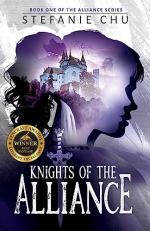|
This section contains 683 words (approx. 2 pages at 400 words per page) |
The Alliance
Thousands of years ago, the land was under one political system. Over the centuries, as towns and cities grew, society was plagued with poverty, conflict, and competition for resources. Fighting classes began to develop, groups of skilled men and women who studied combat honorably defended their homelands. Fighters who made peace with neighboring towns formed larger regions and appointed their strongest members as Region Leaders. These region leaders formed armies to defend and govern the towns in their area.
However, these militarized states only led to larger conflicts between neighboring regions. Rather than developing trade and prosperity, this constant state of feudal warring brought only poverty and death. Some region leaders were desperate to find ways to help the impoverished, while others ruthlessly sought the power to rule and fought to claim more territory.
In a desperate effort to end the constant bloodshed, a great truce was called. A ruling Council was created to make unified decisions and hold authority over all region leaders. The land was then divided into three empires: Althaea, Minetta, and Valenia, marking the birth of the Alliance.
Althaea
Althaeans uphold the belief that only the strongest fighters are fit to rule a region. As a result, region leaders often change hands, if not for glory, then for the scarce resources across its dry lands. Althaea’s economic prosperity comes from minerals and the inventions crafted from hastals, and often comes at the cost of the common people. They are called “flatties," describing them as two flat sides of a coin that mocks their mischievous, two-faced nature. Althaea’s regions include Altha Hills, Evaleen, Axillaire, Nanaka, Ophallen, and the capital region of Althaea Main.
Minetta
The freshest and most abundant resources are produced in Minetta. Anyone seeking to raise a happy, stable family will settle among one of the many forests and harbor towns in the region, often taking up jobs as farmers or merchants. Their culture includes using feathers to garnish their fashion trends, earning them the slur “featherpits." Minetta’s regions include Saon, Oban, and the capital region of Avon.
Valenia
The people of Valenia have long-established peace with each other, eliminating the need for regions and instead operate as small tribal communities. While Althaeans and Minettans continue to fight over resources, Valenians have remained laissez-faire, focusing their efforts on harmonizing with mother nature. Money is rarely used as tribes openly share and work together. They live laid-back lives and sit on unimaginable wealth, earning the slur “swines." The four main tribes are the four fighting classes: Aegis, Umbra, Celta, and Paragon.
Fighter Class
Fighters are trained in one of four styles: Aegis, Umbra, Celta, and Paragon. Aegis are bow users who are in touch with nature and often have an animal companion. Umbras are mixed-weapon fighters who excel at self-defense techniques. Celtas are comprised of healers and spellcasters who are masters of kore. Paragons are brawlers and warriors who use swords, spears, and other close-combat weaponry.
Religion
It is a common belief that all life departs to either the spiritual world of Nagama or Inferna. If the Gods do not deem the soul worthy to join them in Nagama, they are sent to one of the seven flaming gates of Inferna. Orists believe in one deity: Oris, the God of Judgment. He is primarily worshiped by Althaeans and celtas. Quintists, common among Minettans, worship only the five main Gods and Goddesses. Plethorists acknowledge the existence of hundreds of Gods and Goddesses, but a tribe in Valenia will often choose to praise one or two deities.
Technology
The story incorporates various elements of technology throughout its narrative, creating a unique blend of futuristic advancements and medieval-inspired settings. Inventions are made through raw crystals containing energy known as hāstals. Hāstals are enhanced with elemental energy, known as kore, to create new technology. Some notable inventions made by the Hale family include a communication stone known as the comstōne and glowing pebbles that replace candlelight, known as lumastōnes. Some weapons incorporate futuristic elements when the wielder fuses their weapon with their kore.
|
This section contains 683 words (approx. 2 pages at 400 words per page) |




